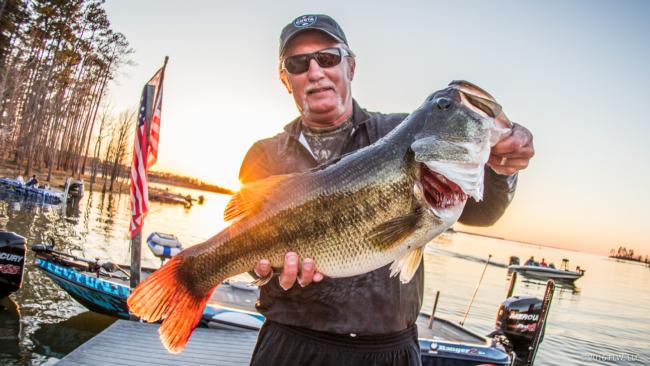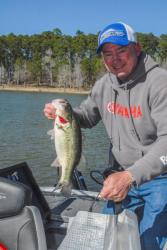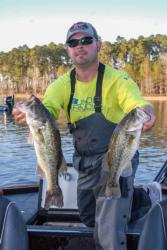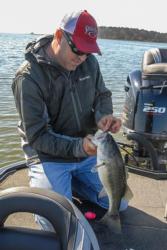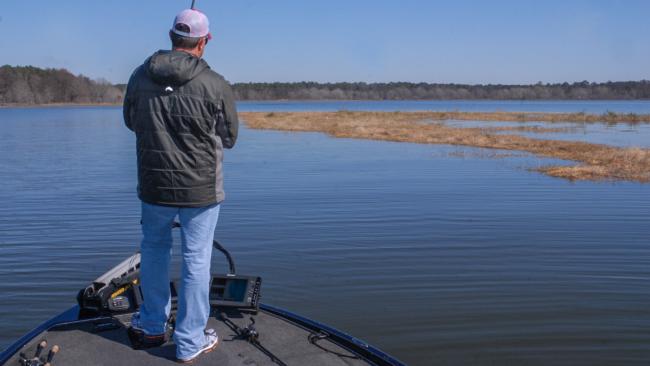It Ain’t Over Until It’s Over
Lessons learned while fishing as a co-angler on Sam Rayburn
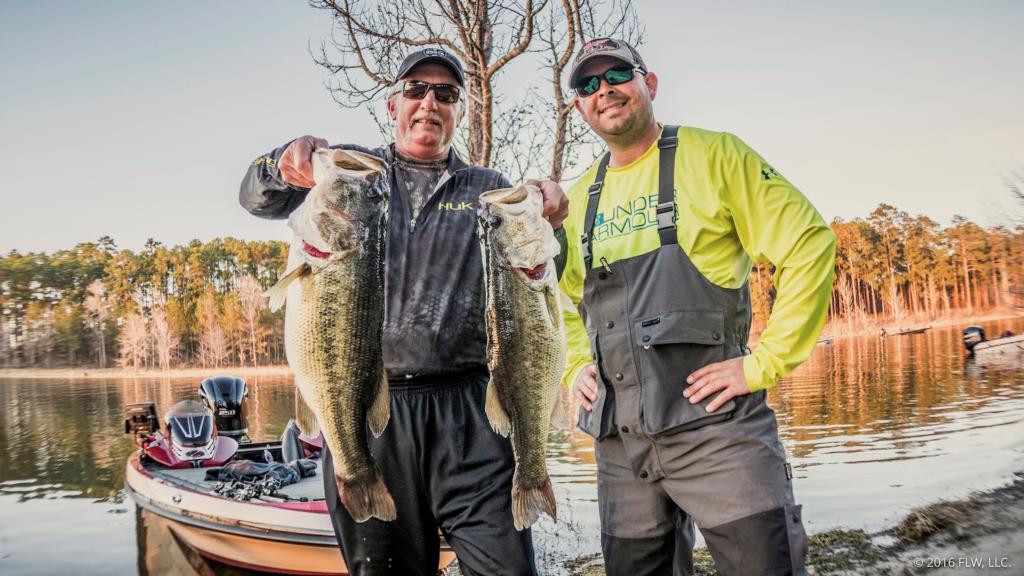
(Matt Williams is a Field Editor for FLW Bass Fishing magazine and a regular FLW contributor. The writer's opinions and observations expressed here are his own, and do not necessarily reflect or represent the views, policies or positions of FLW.)
Co-anglers play an integral role in the FLW fishing model, and it shows. Through the years FLW has always strived to make back-deck opportunities abundant and affordable at a variety of levels, ranging from entry-class FLW Bass Fishing League derbies to the Costa FLW Series and the top-tier Walmart FLW Tour.
While fishing “co” in any league certainly comes with built-in handicaps, back-seaters can still learn a lot from some of their pro partners if they keep their eyes peeled, ears open and pay attention. And take it from me, when the stars line up as perfectly as they did in the Costa FLW Series Southwestern Division season-opener held on Sam Rayburn Reservoir on Feb. 25-27, it’s entirely possible for something truly magical to happen on the back deck.
Somehow, some way, I managed to get lucky and win the darn thing. I’d be lying if I said I’m not pumped about the deal. But in many respects I’m still scratching my head in wonderment as to how in the heck it all came together, especially after getting off to such a shaky start in my first FLW Series event since 2008.
No matter how you slice it, reeling in a measly 9-pound, 6-ounce limit in the opening round doesn’t breed a wealth of confidence toward the possibility of fishing for three days.
Not on Sam Rayburn. Not in the springtime.
Thankfully, my good friend and veteran FLW Tour pro Jim Tutt of Longview, Texas, showed up at my camper door shortly before daylight on day two to remind me where I was. An eternal optimist, Tutt unleashed a peppy pitch that put some mojo dancing in the air.
“Dude, this is Rayburn,” he said. “You know the big ones live here. My guess is you’ll need around 12 pounds to get a check. Just go catch 25 today and you’ll be right back in it.”
Roughly three hours later the unimaginable began to unfold when the first fish of the day – a solid 8 1/2-pounder – gobbled up my Carolina-rigged Yamamoto lizard and headed south.
“That’s a pretty good start,” said Justin Mattingly, my-day two pro partner from Nederland, Texas. “A couple of more solid keepers and you’ll be back in the hunt.”
Amazingly, seven hours and four fish later (one of them a 6-pounder) I was sitting on a whopper 21-11 sack that fell just short of what Tutt had professed it might take to crack a top 10. That’s when Mattingly made a crystal ball prediction that eventually played out like something out of a fairy tale book.
“You’re gonna make the cut, get paired with Kris Wilson on the final day and win this thing,” he said. “Just watch and see.”
Eerie as it seems, Mattingly’s premonition turned out to be right on cue.
Wilson, a personable Rayburn hammer from Montgomery, Texas, who was leading after the opening round with 27-10, managed only 12-5 on day two and fell to fourth place. As fate had it, that paired us in the finals, where Wilson put me on a 14-14 limit that held off Lumberton, Texas, ace Randy Hicks and ultimately sealed the deal.
If you have ever had aspirations about getting into tournament fishing, going co is an avenue certainly worth considering. Stay with it, and you never know what might happen.
Magic does happen on the back deck.
A Learning Experience
As earlier mentioned, fishing from the back deck can be a challenging experience that can be equally rewarding at times, if you allow it to be. It makes no difference if your pro puts you on 6 pounds or 25, there is always something to be learned from a tournament day.
I learned something from each of my pros at Rayburn by watching them fish, studying the way they maneuvered the boat and observing how they managed their minutes. Even more interesting was seeing how they adjusted to the post-frontal conditions that settled in across eastern Texas on the heels of a nasty weather system that passed through the region and brought cold rain, big northwesterly winds and chilly nights that dropped the water temperature as much as 5 degrees just as the tournament got underway.
Here’s a recap:
Day 1
Pro partner: Tim Reed, Collinsville, Okla.
A 58-year-old regional sales manager for a major boat company, Reed has fished Rayburn about half a dozen times over the years and was somewhat shocked to discover how much the lake had changed since his last visit, primarily due to the absence of hydrilla that resulted from months of high, muddy water last spring and summer.
Like most of the field, Reed focused his practice session on the lake’s bountiful patches of shoreline torpedo grass (widely known as “hay grass”), willow bushes and buck brush in hopes of cracking the code on a top-notch fishery that has produced lunkers to 9 pounds for him in the past. He chose to fish toward the southern reaches of the lake on day one, mainly because that’s where he found clearer water.
“I looked around above the 147 Bridge in practice, but I just didn’t like what I saw,” Reed says. “Everybody thinks us guys from Oklahoma like muddy water, but I’m not one of them.”
The area Reed chose to fish was good for solid limits in the 12- to 13-pound range during practice, mainly on watermelon/red Yamamoto Senkos rigged Texas or wacky style, but the pattern let him down on the first day. His primary targets were secondary points with hay grass in 4 to 7 feet of water with newgrowth hydrilla sprigs in slightly deeper water nearby.
He caught 6 pounds, 15 ounces on day one when I was with him and eventually finished in 159th place.
If he had a do-over: “I would have done what my gut told me to do in the first place – go up north to the Canyons and flip bushes all day long,” Reed says. “I kept telling myself to do it, but I kept thinking about getting a limit first and then going to the bushes. I didn’t listen to myself, and it cost me.”
Day 2
Pro partner: Justin Mattingly, Nederland, Texas
Mattingly is a 36-year-old Rayburn salt who spends just about every weekend there or on Toledo Bend. The FLW Series event was his first Triple-A tournament as a boater, and he didn’t make the decision to ante up until three days before the derby got underway.
Fishing on only 14 hours practice, Mattingly chose to run new water he was already familiar with on day two, when I fished with him, after his opening-round plan didn’t shake out – he caught just three fish for 4 pounds, 15 ounces the first day.
His primary pattern revolved around targeting hay-grass mats bordering a major spawning flat at the lake’s southern reaches using Carolina-rigged watermelon/red and green pumpkin lizards. He was throwing the rig in combination with a 4-foot leader, 3/4-ounce tungsten weight and 7-foot, 6-inch Falcon Carolina Cara rod, which allowed for lengthy casts and good hooksets from a distance.
Mattingly paid particular attention to points in the mats, and he fished them slowly and meticulously, oftentimes putting his Power-Poles down so we could work the potential sweet spots thoroughly from both sides. The young pro could have easily paralleled the cover and forced me to fish used water, but in most cases he chose to cast to the edge instead. The main key was landing the bait just inside the outside edges of the mats in about 5 to 7 feet of water, where the prespawners were staging.
He put together a limit on the second day but finished in 180th place.
If he had a do-over: “I would have invested more time in practice and located more prespawn areas similar to what we fished that I could have fished in different winds,” Mattingly says.
Day 3
Pro partner: Kris Wilson, Montgomery, Texas
Wilson is a Rayburn big stick who has registered nine top 10s in Costa FLW Series events in Texas, including one win on Rayburn. That’s in just 15 FLW tournaments. He even won the 2012 Costa FLW Series Southwestern Division Angler of the Year title with three top 10s and an 18th-place finish that year (the schedule included four stops back then). Wilson has also won numerous non-FLW individual and team events on Sam Rayburn and Toledo Bend. Translation: He’s a good draw anywhere he goes and a definite ringer in this neck of the woods.
A well-known Carolina-rig specialist, Wilson didn’t surprise me when he told me I’d better come prepared to drag on the final day. He seemed a little apprehensive about where he was going to soak his Big Bite lizard at first, and rightfully so. The prespawn pattern that had carried him to the top of the leaderboard on day one with 27 pounds, 10 ounces had pretty much died on day two.
The majority of Wilson’s day-one sack came at middepth ranges along drains leading into spawning flats, but the fish seemingly vanished after the cold front pushed through and high pressure settled in.
“I looked for them out deeper and shallower and was never able to find them,” he says. “I’m not sure if the falling water temperature messed with them or what, but something did. They just left.”
Wilson began the finals targeting offshore drains with scattered grass in water ranging 8 to 12 feet deep and boxed a solid limit in short order. That seemed to settle his spirit, and he spent the remainder of the morning fishing his game – bouncing around between shoreline hay grass and middepth drains in hopes of finding a kicker or two that he needed to make a charge at the leader, Ricky Guy of Humble, Texas.
With time waning and a big afternoon sun beating down on the shallows, the 38-year-old pro settled in on the outside edge of hay-grass mats in 4 to 7 feet of water for the final three hours of the day and eventually managed to cull up a couple of times. His arsenal included a 1-ounce tungsten weight, a lengthy leader and a custom-built 7-foot, 8-inch rod that helped him zing his 6-inch green pumpkin lizard long distances with very little effort.
“I think making long casts right to the edge of hay grass is a big key,” he told me. “The water is fairly shallow, so the farther back you can stay from it the less the chance of spooking the fish.”
Wilson ended the final day with the second-heaviest sack (15-2, tied with James Caldemeyer), but it wasn’t enough to move him up in the standings. He finished in fourth place with 55-1 and grabbed a $12,500 check that boosted his lifetime FLW earnings to $106,737.
If he had a do-over: “I wouldn’t change anything on the first or third days, but on day two I should have gone and flipped the bushes when my fish moved,” he says.
